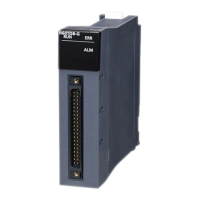1000
7 APPLICATION INSTRUCTIONS
7.24 Indirect Address Read Instructions
• These instructions store the indirect address of the device specified by (s), and stores it in the device specified by (d). The
address stored in the devices specified by (d)+0 and (d)+1 is used for indirect addressing of the device in the program.
• Digit specification of bit device or bit specification of word device in (s) is not permitted
• For the indirect specification of devices, refer to the following.
MELSEC iQ-R CPU Module User's Manual (Application)
• Index specification of labels is not supported. When using a label by specifying it in (d), follow the method below.
There is no operation error.
(1) The address of W100 is stored in D100 and D101.
(2) The data (address of W100) stored in D100 and D101 is specified.
(3) "1234" is written to W100.
Label Description
Global label specifying a device When using it as an indirect address, use the indirect specification of the device specified in the global label.
■Example of ST
ADRSET(TRUE , intVar , gvAddr); // Read the intVar indirect address to gvAddr.
INC (TRUE , @D0);// Use the indirect specification of device D0 specified for gvAddr.
Automatic assignment global label/
local label
Transfer the indirect address to the device and use the indirect specification of the transfer destination device.
■Example of ST
ADRSET(TRUE , intVar , lvAddr); // Read the intVar indirect address to lvAddr.
DMOV(TRUE , lvAddr , D0);// Transfer the indirect address, which has been read to lvAddr, to the device.
INC (TRUE , @D0);// Use the indirect specification of the device to which the indirect address was transferred.
D0
D1
D101
D100
W100
1234
(1)
(3)
(2)
ADRSET W100 D100
MOV K1234 @D100
Address of
W100
Device area

